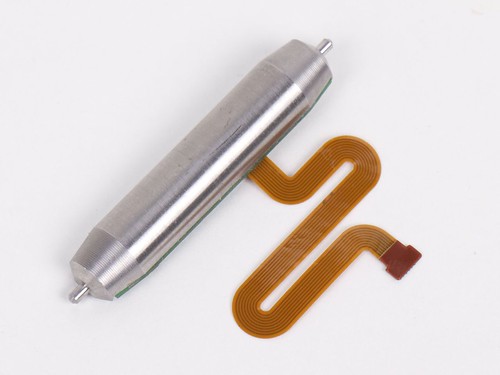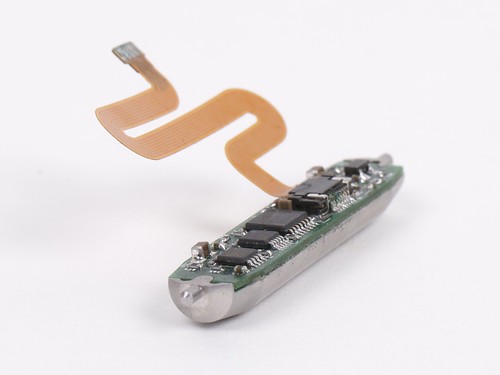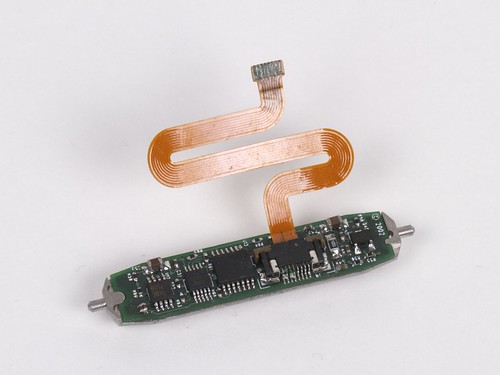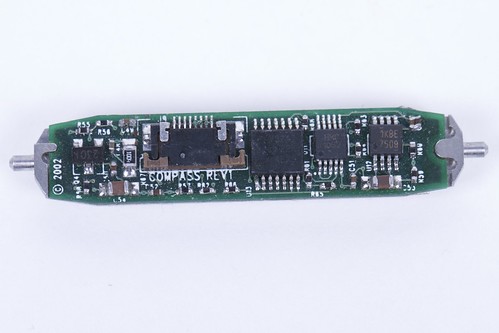From the files of TGIMBOEJ comes this piece of unusual hardware.
What does it do? Where did it come from? What does it want from us? And why is it shaped like that? An interesting little mystery.
The overall size of the object is about 1.75 inches long. The cylindrical part appears to be made of 300-series stainless steel or a similar alloy. The back side of the circuit board is flat, without any components (yep, pried it up to look).
Now, I’ve found most of the answer already, but I don’t know the manufacturer or specific application. Do you recognize it, or can you guess what it is or what it’s from?
In the pictures here, the chip markings are obscured– that would be too big of a hint. We’ll add clearer pictures tomorrow if no one gets it by then.
Update:
A couple of folks were able to piece it together from the pictures here. On twitter, Henrik Sandaker Palm (@HSPalm)
wrote, “I bet one of those chips are some sort of gyroscope or directional sensor…”
And yes, that’s quite correct. One of our anonymous commenters (and, madam or sir, please stand up and take credit!) explained how they came to the same conclusion:
-
“I will guess that this is part of a precision compass based on the following reasoning.
1. Whatever is on the board is a sensor. A screen driver or other controller would have more than a single eight wire connection, and there are no other visible interfaces. I am assuming that there are no other electronics embedded in the steel block because they looked under the board and didn’t mention any.
1b. The fact that part numbers would be too obvious implies that at least one of the components is highly specialized. This is consistent with there being a sensor on the board, although there are many other specialized devices it could be.
2. The board is meant to stay level. There is no good reason to have a large counterweight and flex connector on a circuit board unless it is meant to maintain the board in a level state. There is a good possibility that this was also mounted in a swivel along an orthogonal axis to provide freedom on both pitch and roll (this may be why the flex circuit is S-shaped instead of straight).
3. The only sensor I can think of that needs to be level is a compass. The sensor could also be an accelerometer provided it was meant to be used while the device was stationary to measure the force of gravity, because movement would cause the board to shift and invalidate the readings. There does not appear to be any encoder components that could take the rotation into account.
4. This is probably a precision instrument because the counterweight appears to be fully machined instead of cast, which implies it is part of an expensive device manufactured in low quantities.”
Correct on all counts. The particular shape and size of the flex-circuit connector indicates that the assembly is free to rotate a small amount not only in one axis, but in two, as though it were mounted as a compass in a gimbal (like so), with a weight to keep the circuit board level.
Here’s another picture, now with the flex-cable disconnected, and the chips visible:
Besides the obvious point– that the board is labeled “compass” under there, the second chip from the right is an HMC1052 two-axis compass chip. That’s not so very different from the HMC5843 that we demonstrated in this project.
The remaining mystery is this: exactly what did it come out of?
It would be nice if the manufacturer labeled what it came from. But, we can narrow it down a little bit. As the commenter noted, the machined stainless suggests that it’s part of “an expensive device manufactured in low quantities.” Add to that, (1) a custom flex cable is used rather than just a longer wisp of off-the-shelf flex cable or plain thin wires and (2) the circuit board and stainless are carefully machined so that the board can only fit in one way. Custom flex cables are expensive in low quantity. Engineering parts such that things can only fit together one way is usually done for reasons of precision in mass production. Together these suggest that perhaps it came from something (yes) expensive, but mass produced none the less. The fact that it’s in a gimbal mount suggests that whatever it was originally in moved, for example in a vehicle. The fact that it relies on a weight to operate suggest that it wasn’t designed to operate in zero-g, leaving “only” air, sea, and land vehicles as possible suspects. If you can come up with any other evidence or things to check that might help identify what it might be, we’d love to hear about it in the comments.








Thermal Printer Head for printing receipts etc.???
ditto
looks like some kind of solid state gyroscope. SS part is to keep it level on one axis. Possibly from something like a segway.
It’s one of those capsules from the first season of Fringe.
LoL..
Like!
Remember! Raid old appliances for parts/components
I’ll say it’s a ho-humm component…
Part of the LCD driver from a laptop/netbook meant to be mounted in the hinge.
It’s a twitter enabled toilet roll holder
I will guess that this is part of a precision compass based on the following reasoning.
1. Whatever is on the board is a sensor. A screen driver or other controller would have more than a single eight wire connection, and there are no other visible interfaces. I am assuming that there are no other electronics embedded in the steel block because they looked under the board and didn’t mention any.
1b. The fact that part numbers would be too obvious implies that at least one of the components is highly specialized. This is consistent with there being a sensor on the board, although there are many other specialized devices it could be.
2. The board is meant to stay level. There is no good reason to have a large counterweight and flex connector on a circuit board unless it is meant to maintain the board in a level state. There is a good possibility that this was also mounted in a swivel along an orthogonal axis to provide freedom on both pitch and roll (this may be why the flex circuit is S-shaped instead of straight).
3. The only sensor I can think of that needs to be level is a compass. The sensor could also be an accelerometer provided it was meant to be used while the device was stationary to measure the force of gravity, because movement would cause the board to shift and invalidate the readings. There does not appear to be any encoder components that could take the rotation into account.
4. This is probably a precision instrument because the counterweight appears to be fully machined instead of cast, which implies it is part of an expensive device manufactured in low quantities.
I’m interested in finding out more about this, keep us updated!
I agree.. seems designed to stay levelled..
A quick suggestion.. I regularly follow a website called "Hacked Gadgets" and every week they have a competition called "Name the thing" where people have to guess the name of a certain hardware component.. This would be the ideal candidate for one of those contest.. :)
Perhaps you could send the picture to them and "spread" the quest :)
Igor
Woot! I got it! This was a great challenge; there were just enough unique design features to lead to the answer while still being sufficiently obtuse. Keep up the great work. This is one of my favorite websites!
-Cody Wheeland
P.S. I’ve been trying to come up with a unique clock for years, so I’m still mad that you guys thought of the bulb dial before I did…
Perhaps its some sort of sensor to see if a laptop screen has closed, built into a hinge?
i recon its some kind of magnetic tape reading head.. or some kinda sensor that runs along a belt/tape. the way the cable is it looks like its ment to move up and down a little. im not sure though heh was a wild guess
Remember! Raid old appliances for parts/components
Not laptop EL driver as the high voltage output would need something more insulated than that ribbon cable. Guessing also not thermal print head as the higher current would (I’m guessing here!) need thicker conductors than that ribbon cable. If the material that made up the half-cylindricalo case and the now pried-off cover is magnetic then it’s also no kind of magnetic sensor or reader ad the case would shield it. Since the case IS metal, it’s also no electric field sensor either. Leaves inertial sensing, or something else physical.
Might be a load cell.
Is it an accelleration sensor that fires an airbag?
I don’t think it is made of steel as a counterweight (not heavy enough – the cable would trouble the exact level) Depending on the shape and material I think it might be the sensor element for a computer controlled telescope or camera (could be an helicopter mounted IR camera or something like that). I guess it is made of stainless steel, because it is not only the sensor, but also a rotary mount for something that is kind of heavy weight. Please excuse my poor english. ;)
Best regards, Tom
I would have to say it looks like it may be part of an inertial guidance system
possibly part of a gimballed gyro-stabilized platform system
or perhaps part of a video camera stabilization mechanism
first maybe from a vehicle, could be plane car maybe even a tank
or maybe something like a telescope guidance
which would make sense cause it would need to know compass readings
and be able to swivel and move up and down
It comes maybe from a motion platform or a stewart platform http://en.wikipedia.org/wiki/Stewart_platform ?
cheers,
Jb
I’m pretty sure I’ve seen a component like this in a marine uplink antenna gimbal, used to keep a microware downlink antenna pointed at the satellite independent of the sea motion on a ship.. The gimbal itself takes care of most of the movement, but the compass, gyro and acc modules are used to take measurements and make corrections as apropriate.
Systems like this are provided by LinkScape (LinkScape Typhoon) http://www.linkscape.net/download/Linkscape_Brochure-VSAT.pdf
after reading the update, I thought that it could be part of a gyroscope instrument on an aircraft, or a part of a sensor array on an airplane Black Box ( or Flight Data Recorder) system.
P.S. where did evil mad scientist get this part??????
The article states that EMSL got the part from TGIMBOEJ, which is "The Great Internet Migratory Box Of Electronics Junk"
I’m also somewhat surprised that I remembered exactly what the acronym stood for, though I looked it up just to be sure. :)
It was probably housed in a gimbal to keep it level, as part of a ships navigation system or something.
Could also have come out of an inertial navigation system. This is a system with a bunch of sensors mounted inside a gyroscope. The inertia caused by the spinning gyroscope maintains roll pitch and yaw of the sensors inside.
based on the update that it is stainless steel weight, i would think aircraft or marine use of some sort.
I’m sure its Marine in nature. I’m taking a shot in the dark and going to say its part of a compass/stabilization system to align possible antenna or satellite dish while at sea.
I don’t think its aviation as the aviation industry hates weight. A nice little solid chunk of metal wouldn’t "fly" so to speak :)
Josh F
How about for a Satellite Dish (Dish or DirectTV) for a Motorhome that will track the Sat while moving so they can watch TV on the road? They are made by serveral mfgs. The limited tilt motion of this gadget would be perfect. There is not much for/aft of side to side motion in an RV but there is some.
JohnK (EvilMinion)
PS: I just moved to Sunnyvale and found I amworking just around the corner from EMSL. :-)
Thats easy .Gyroscopic stabilization sensor for ,,,, "Segway ".invented @ 2002 mass produced in small amounts(if that makes any sense) because of its innovational design & the $5,900 to $6,400.pricetag. Your welcome. @PEACE Diego.A,D,Salazar
Why would a Segway need a compass?
Windell H. Oskay
drwho(at)evilmadscientist.com
http://www.evilmadscientist.com/
surveying equipment, perhaps?
That was going to be my guess. Because I think the cable would interfere with any sort of rapid movement of a gimble, the slow adjustment of survey equipment makes sense to me.
I would like to know how this got in a junk pile? If I’m not mistaken it is PART of a gyroscope. Government Gyroscope, used in the missile guidance systems. I designed and worked for a company that built a fiber optic gyroscope that became the competition to this one shown here. I patented the fiber version of this. We went full production before the 1st Iraqi war, not knowing it was going to be used in the warheads for guidance pinpoint accuracy. The accuracy was pulled to within a couple inches of it target. Also, the metal material is polished aircraft aluminum.
This wouldn’t likely work well in a missile, as it’s a 2D gyro in a gimbal mount, and so would require very constant velocity to give any kind of a meaningful reading.
Also, the base material is definitely not aluminum. Appears to be 304SS.
Windell H. Oskay
drwho(at)evilmadscientist.com
http://www.evilmadscientist.com/